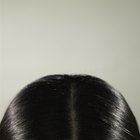
In years past, women had to have their hair colored in a salon or take a big risk and gamble on coloring their hair at home. Technology has advanced in such a way that it’s very easy to color hair at home. The boxed hair color that is available at most stores has become easier to use. In addition, beauty supply stores provide hair color to the general public that used to only be available in salons.
The Facts
Many women in the United States color their hair at home. Some women use permanent color to drastically alter the color while others just color to cover up gray hair. The standard time that women should wait between color treatments is anywhere from four to six weeks. Hair can be dyed more frequently if it’s being colored with semi-permanent color. Also, the condition of the hair can determine how often it should be colored.
Permanent
Permanent hair color is used most often to change hair color to a different color. It can be used for minor changes and to cover gray hair as well. Permanent hair color theoretically does not wash out of the hair and will remain until the next time that it is colored. However, the hair color will wash out and fade over time.
Permanent hair color is harder on hair than semi-permanent and temporary hair dyes because it lifts and removes color and then deposits color. If used too often, it can lead to porosity and protein loss in the hair. You shouldn't color your hair at home with permanent color more than once every four to six weeks. Permanent hair color can be used more often than that if needed, but it should be avoided due to the possibility of damage to the hair.
Semi-Permanent
Semi-permanent color is a way to darken and enhance hair color without as much commitment. Unlike permanent hair color, there is no ammonia or peroxide used when coloring hair with semi-permanent hair dye. Thus, it only deposits color and does not lighten it. Because ammonia and peroxide are not used, semi-permanent color is gentler on the hair. Semi-permanent hair color generally washes out between six and 24 shampoos.
Semi-permanent hair dye can be used on the hair as often as every two weeks. It does not damage the hair. To maintain rich color, dye hair with semi-permanent color at least every four to five weeks.
Bleach
It can be difficult to bleach hair at home. Bleach is the most damaging color process done to the hair. In addition, it’s tricky to color roots as they grow. Bleach is hydrogen peroxide and strips the melanin from the hair. Alkaline is used with the bleach to open up the hair’s cuticle and allow it to go very light. This can be extremely irritating to the scalp.
Coloring hair at home using bleach should not be done more often than every four weeks. Also, it is imperative that only the new growth is bleached. Unlike permanent and semi-permanent hair dye, bleach should not be used on hair that has already been bleached. If it is used on already bleached hair, the hair could break off or become gummy or mushy.
Warning
The frequency at which hair should be colored at home depends on hair types and condition of the hair. Hair that is relaxed or permed should not be colored at home.
Related Articles

How Often Can You Color Hair Without ...

Ways to Prevent Damage During Hair ...

Difference Between Permanent Hair Color ...

How to Change Black Hair Color

The History of Hair Dye Colors

How Are Hair Colors Inherited?

How Can I Naturally Remove ...

Can I Dye My Hair After Bleaching It?

About Hair Bleaching

If I Dyed My Naturally Blonde Hair Too ...

How to Get Peroxide Out of Hair

Instructions for How to Use a Wella ...

How to Make Hair Dye Lighter

How to Remove Excess Hair Dye

How to Keep Burgundy Hair Vibrant

How to Use Peroxide to Fade Out Black ...

How to Make a Riflessi Color Renewal ...

How to Correct Gold Tones in Hair Color

Highlights Vs. Lowlights

Why Does White Hair Turn Yellow?
References
Writer Bio
Yvonne Van Damme is a freelance writer based in Seattle. She has been writing for several years with a focus on criminal justice and legal topics. In addition to various websites, she has been published in several academic journals. Van Damme holds a Bachelor of Arts in law, society and justice and sociology from the University of Washington.
Photo Credits
Image by Flickr.com, courtesy of Amanda